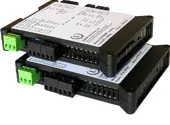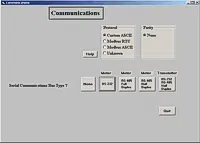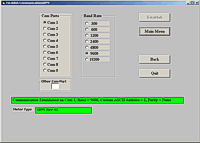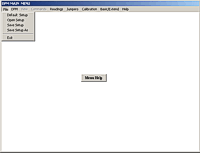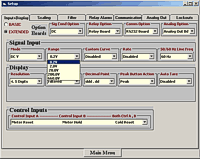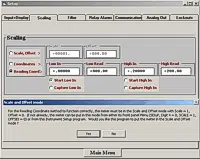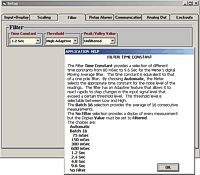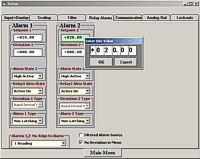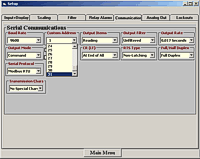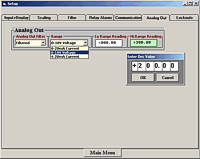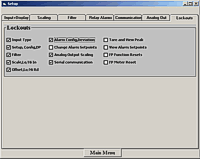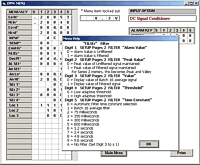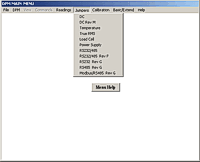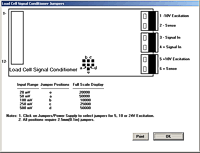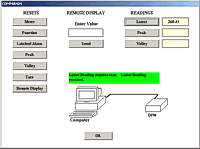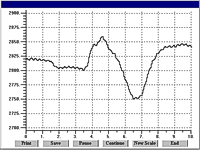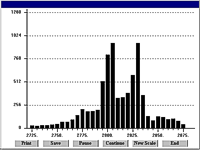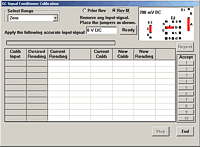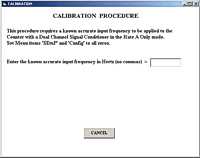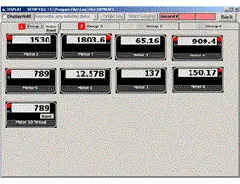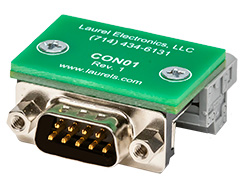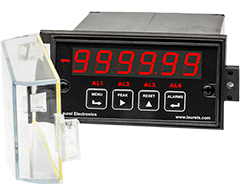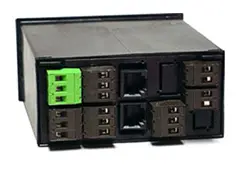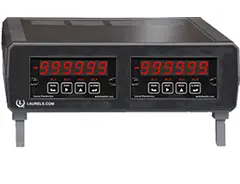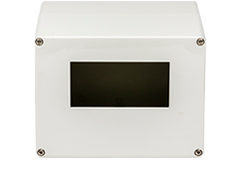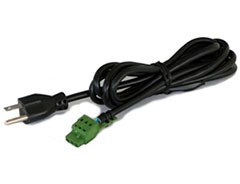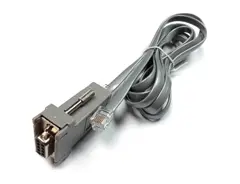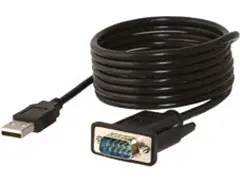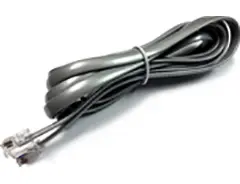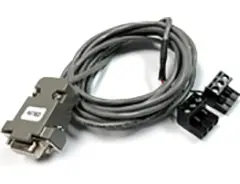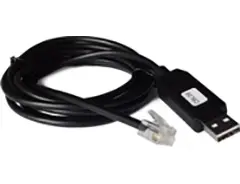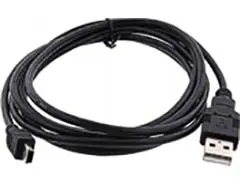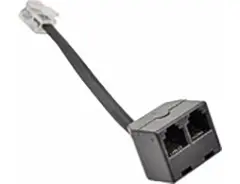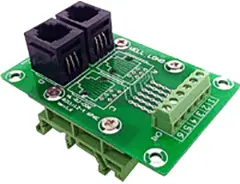- Description
- Specifications
- Setup Software
- Mechanical
- Documents
- Technical FAQ
- Applications
- Accessories
Features
- 20, 50, 100, 250 & 500 mV full scale ranges, 1 microvolt sensitivity
- Accuracy of 0.01% of reading ± 2 counts
- 4- or 6-wire hookup to avoid lead resistance effects
- 10 Vdc excitation to power four 350-ohm load cells in parallel (isolated)
- All input ranges are user selectable and factory calibrated
- Up to 60 conversions per second, Ideal for peak or valley capture
- Digital span adjust from 0 to ±99,999, zero adjust from -99,999 to +99,999
- Front panel scalable to ±99,999 for use with current shunts
- 1/8 DIN size with bright red or green 0.56" (14.2mm), high LED digits
- Transducer excitation output, 5, 10, 12, or 24 Vdc (isolated)
- Power 85-264 Vac / 90-300 Vdc or 10-48 Vdc / 12-32 Vac (isolated)
- Operating temperature from -40°C to 70°C (-40°F to 158°F)
- Wide choice of Plug-in-Play options:
- 2 or 4 relays, mechanical or solid state, for alarm or control (isolated)
- 1 or 2 Analog output, 4-20 mA, 0-20 mA, 0-10V, or -10V to +10V (isolated)
- Communications: Ethernet, WiFi, USB, RS232, RS485 (isolated)
- Extended DPM allows up to 180 data points for custom curve linearization
and a rate derived from consecutive readings
Certificates of Compliance
The Laureate™ 1/8 DIN Panel Meters for strain gauge load cell
are 5-digit panel meters with exceptionally high accuracy and stability for use with low-level signals.- Load cell meter operation provides sensitivity down to ±20 mV full scale for use with 2 mV/V load cells at 10V excitation. Ratiometric operation automatically compensates for changes in excitation. The 5 digit display can be scaled for direct readout in engineering units, such as pounds, kilograms or PSI. Scaling can be via front panel pushbuttons or a computer. Zero may be set from -99,999 to +99,999. Range may be scaled from 0 to ±99,999. Digital scaling and calibration eliminate drift caused by potentiometers in non-microcomputer based meters.
- DC microvoltmeter operation provides sensitivity down to ±20.000 mV full scale with 1 µV resolution for use with 2 mV/V load cells. A display span of 99,999 counts with sensitivity of 0.2 µV per count can be obtained by applying a digital multiplier of five. A moving average digital filter assures quiet readings in electrically noisy environments.
Meter accuracy in ratiometric bridge operation is 0.01% of reading ± 2 counts. Custom curve linearization, which is available with the optional Extended main board, can extend the working range of load cells. Custom curve linearization also allows greater accuracy to be achieved with lower cost, less linear load cells.
A built-in isolated excitation supply can provide up to 120 mA of current at 10V to power four 350-ohm load cells in parallel. The panel meters operate in a ratiometric mode to eliminate errors due to supply variations. When excitation sense inputs are used in 6-wire connection, the panel meters compensate for variation in resistance of the transducer leads, thereby allowing long cable runs.
All signal conditioner board ranges are factory-calibrated, with calibration factors for each range securely stored in an onboard EEPROM. These factors can be scaled via software to accommodate external shunts, enabling field replacement of signal conditioner boards without necessitating recalibration of the associated panel meters. For optimal accuracy, factory recalibration is recommended annually. All Laurel Electronics instruments undergo factory calibration using the industry-leading Fluke calibrators, which are recalibrated yearly and certified traceable to national standards, ensuring the highest level of precision and reliability.
The optional extended Laureate computer board enhances Laureate Panel Meters by displaying rates derived from successive readings and enabling highly accurate custom curve linearization. For example, it can calculate liquid volume or flow rate in a horizontal cylindrical tank using levels from a 4-20 mA transmitter. Setup is straightforward: users input up to 180 data points into a spreadsheet or text file, and the computer calculates spline-fit segments, which are then downloaded to the panel meters for precise operation.
Laureate Panel Meters are easily programmed with Laurel’s free Instrument Setup Software, downloadable from our website and compatible with Windows PCs, requiring a data interface board for setup.
Scaling is from -99,999 to +99,999 (five full digits) with any decimal point to display readings in engineering units, such as PSI. Three scaling methods are user selectable: scale and offset, two-point method, and system-level calibration using actual transducer signals.
High read rate of up to 50 or 60 conversions per second, the Laureate™ Panel Meters use Concurrent Slope (US Pat. 5,262,780) analog-to-digital conversion to integrate signals over a full power line cycle (50 Hz or 60 Hz). This read rate enables peak and valley capture, real-time computer interfacing, and control applications. Peak and valley values are automatically captured and can be viewed using Laurel’s free Instrument Setup Software (compatible with Windows PCs) or transmitted as serial data.
- An unfiltered selection provides true peak and valley readings and aids in control applications.
- A batch average filter selection averages each 16 conversions.
- An adaptive moving average filter selection provides a choice of 8 time constants from 80 ms to 9.6 seconds. When a significant change in signal level occurs, the filter adapts by briefly switching to the shortest time to follow the change, then reverts back to its selected time constant. An Auto setting selects the time constant selection based on signal noise.
Scale and offset can be provided by either of two user-selectable methods:
- With the coordinate reading method, the panel meters reads the high and low signal values, and the user enters the desired high an low reading values. The panel meters then calculates the span multiplier and offset. This method is ideal if an external calibration reference is available.
- With the manual coordinate method, the user enters the high and low input values in Volts plus the desired high and low reading values. This method is suitable if no external calibration reference is available.
Two tare functions: auto-tare and manual tare. In auto-tare, an input line is grounded by an external pushbutton. This causes the current weight, which is normally the empty weight of the container to be stored in memory as an offset. In manual tare, the tare value can be entered manually via the front panel or a computer using Laurel's free Instrument Setup Software. For instance, the tare value may be the stated empty weight of a truck or rail car. Pressing the Reset button on the front panel toggles the display between gross weight (total weight on the scale) and net weight (gross weight with tare subtracted).
Peak and valley values are automatically captured. These may be displayed via a front panel pushbutton command or control signal at the rear connector, or be transmitted as serial data.
Two rear panel control Inputs (CMOS/TTL levels, logic 0 = tied to digital ground, logic 1 = open) or dry contacts that can be set to control / activate 14 meter commands.
An (isolated) 5, 10, 12, or 24 Vdc excitation output is standard to power transducers or two-wire transmitters. Ratiometric operation, which automatically compensates for changes in the applied excitation, is jumper selectable for applications, such as bridges, where the signal to be measured is proportional to the excitation level.
Load Cell Meter Connections


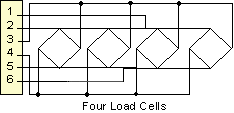

Seat belt tensile strength testing using Laureate panel meters.
The three meters display Force, Displacement and Speed.
Load Cell Inputs and DC Microvoltmeter Inputs
| Input Range mV | Resolution | Input Resistance | Error at 25°C |
|---|---|---|---|
| ±20.000 | 1 µV | 1 GΩ | ±0.01% of full scale ±2 counts |
| ±50.000 | 1 µV | ||
| ±100.00 | 10 µV | ||
| ±250.00 | 10 µV | ||
| ±500.00 | 10 µV |
| Full-Scale Input, mV | Zero Adjust | Span Adjust | Input Resistance | Error at 25°C |
|---|---|---|---|---|
| ±20.00 | 0 to ±99,999 | 1 GΩ | ±0.01% of reading ±2 counts |
|
| ±50.00 | -99,999 | |||
| ±100.00 | to | |||
| ±250.00 | +99,999 | |||
| ±500.00 | ||||
| Recalibration: All ranges are calibrated at the factory. Recalibration is recommended every 12 months. | ||||
| Accuracy | |
|---|---|
| Error at 25°C | ±0.01% of reading ± 2 counts in ratiometric mode, ±0.01% of full scale ± 2 counts in absolute mode. |
| Span tempco | 0.0015% of reading/°C |
| Zero tempco | 0.1 µV/°C |
| Load cell linearization | Programmable using Extended meter version |
| Noise Rejection | |
| CMR, DC to 60 Hz | 130 dB |
| NMR at 50/60 Hz | 90 dB with min filtering |
| A-to-D Conversion | |
| Technique | Concurrent Slope™ (Pat 5,262,780) |
| A-to-D rate | 60/s at 60 Hz, 50/s at 50 Hz |
| Output update rate | 56/s at 60 Hz, 47/s at 50 Hz |
| Display update rate | 3.5/s at 60 Hz, 3/s at 50 Hz |
| Display | |
| Readout | 5 LED digits, 7-segment, 14.2 mm (.56"), red or green |
| Range | -99999 to 99999 or -99990 to 99990 (count by 10) |
| Indicators | Minus sign, 2 red LED lamps |
| Power Supply Boards (one required) | |
| Voltage, standard | 85-264 Vac or 90-300 Vdc |
| Voltage, optional | 12-32 Vac or 10-48 Vdc |
| Frequency | DC or 47-63 Hz |
| Power consumption (typ. with four 350Ω load cells at 10V) | 2.4W @ 120 Vac, 2.7W @ 240 Vac, 2.5W @ 10 Vdc, 2.6W @ 20 Vdc, 2.75W @ 30 Vdc, 3.0W @ 40 Vdc, 3.35W @ 48 Vdc |
| Power Isolation | 250V rms working, 2.3 kV rms per 1 min test |
| Excitation Output (standard) | |
| 5 Vdc | 5 Vdc ± 5%, 100 mA (jumper selectable) |
| 10 Vdc | 10 Vdc ± 5%, 120 mA (jumper selectable) |
| 12 Vdc | 12 Vdc ± 5%, 100 mA (jumper selectable) |
| 24 Vdc | 24 Vdc ± 5%, 50 mA (jumper selectable) |
| Output Isolation | 50 Vdc from signal ground |
| Ratiometric operation | Automatically compensates for changes in excitation level. |
| Analog Output Board (one optional) | |
| Output levels | 4-20 mA, 0-20 mA, 0-10V, -10 to +10V (jumper selectable) |
| Current compliance | 20 mA at 10V ( > 5 kΩ load) |
| Voltage compliance | 12V at 20 mA (< 600 Ω load) |
| Scaling | Zero and full scale adjustable from -99999 to +99999 |
| Resolution | 16 bits (0.0015% of full scale) |
| Isolation | 250V rms working, 2.3 kV rms per 1 min test |
| Relay Output Boards (one optional) | |
| Dual magnetic relays | 2 Form C, 10A max, 440Vac or 125Vdc max, 2500VA or 300W |
| Quad magnetic relays | 4 Form A (NO), 10A max, 440Vac or 125Vdc max, 2500VA or 300W |
| Dual solid state relays | 2 Form A (NO), AC or DC, 0V - 400V, 120Ma, 35Ohms (max at On-State) |
| Quad solid state relays | 4 Form A (NO), AC or DC, 0V - 400V, 120Ma, 35Ohms (max at On-State) |
| Relay commons | Isolated commons for dual relays or each pair of quad relays |
| Relay isolation | 250V rms working, 2.3 kV rms per 1 minute test |
| Relay latching modes | Latching or non-latching |
| Relay active modes | Active on or off, active high or low |
| Hysteresis modes | QA passband mode, split hysteresis, span hysteresis |
| Communication Boards (one optional) | |
| Board selections | RS232, RS485 with dual RJ11 connectors, RS485 with dual RJ45 connectors, USB, Ethernet, USB-to-RS485 gateway, Ethernet-to-RS485 gateway, WiFi with built-in antenna plus USB & RS485, WiFi with external antenna plus USB & RS485 |
| Protocols | Laurel Custom ASCII (serial), Modbus RTU (serial), Modbus TCP (Ethernet or WiFi) |
| Digital addresses | 247 (Modbus), 31 (Laurel ASCII), |
| Isolation | 250V rms working, 2.3 kV rms per 1 min test |
| Signal Connections | |
 |
|
| Environmental | |
| Operating temperature | -40°C to 70°C (-40°F to 158°F) |
| Storage temperature. | -40°C to 85°C (-40°F to 185°F) |
| Relative humidity | 95% at 40°C, non-condensing |
| Protection | NEMA-4X (IP-65) when panel mounted |
| Mechanical | |
| Enclosure | 1/8 DIN, high impact plastic, UL 94V-0, color: black |
| Mounting | 1/8 DIN panel cutout required: 3.622" x 1.772" (92 mm x 45 mm). |
| Dimensions | 4.68" x 2.45" x 5.64" (119 mm x 62 mm x 143 mm) (W x H x D) |
| Maximum panel thickness | 4.5 mm (0.18") |
| Tightening Torque - Connectors | Screw terminal connectors: 5 lb-in (0.56 Nm) |
| Tightening Torque - Pawls | Digital Panel Meter Case Pawls: 5 lb-in (0.56 Nm) |
| Weight of base meter | 210 g (7.4 oz) typical (DPM, counter, timer, 6-digit remote display) |
| Weight of option boards | 30 g (1.0 oz) typical per board (analog output, relay output, communications) |
| General | |
| Programming Methods | Four front panel buttons or via Laurel's free Instrument Setup Software, which runs on a PC under MS Windows. |
| Security | Lockout options include using the front panel buttons, the free Instrument Setup Software, or a hardware jumper. |
| Warranty | 3 years parts & labor |
| Recalibration: All ranges are calibrated at the factory. Recalibration is recommended every 12 months. | |
Free Instrument Setup Software for Series 2 Laureates
Free Downloadable Windows-based Instrument Setup (IS) software (Data Interface Board Required) for use with our programmable Digital Panel Meters, Scale Meters, Counters, Timers, Remote Displays, and Transmitters, are an easy method to set up Laureate 1/8 DIN digital panel meters, counters, timers, remote displays, and DIN-rail transmitters, as explained in the Instrument Setup Software Manual. Laureate 1/8 DIN instruments can also be set up from the front panel, as explained in their respective Owners Manuals. Instrument Setup software is of benefit whether or not the PC is connected to the instrument.
- When the PC is connected to the instrument, Instrument Setup software can retrieve the setup file from the instrument or open a default setup file or previously saved setup file from disk View Setup, then provides graphical user interface (GUI) screens with pull-down menus applicable to input, display, scaling, filtering, alarms, communications, analog output, and front panel lockouts. Fields that are not applicable to the instrument as configured are either left out or grayed out. Clicking on any item will bring up a detailed Help screen for that item. After editing, the setup file can be downloaded, uploaded to the instrument, or saved to a disk. The same setup file can then be downloaded into multiple instruments.
- When the PC is not connected to the instrument, the above GUI screens can be used to set up a virtual instrument. The setup file can then be saved to disk. Switching toView Menu then brings up a screen with the required front panel programming steps. This view can be printed out for use at the instrument site and to serve as a hard copy record.
Download Free Instrument Setup Software
Installation
Set User Account Control (UAC) of MS Windows to "Never notifiy me" so that Instrument Setup Software can create directories. The UAC change screen can be reached as follows:
- Under Windows 7, click on the Windows Start button in the lower left of the desktop and enter "UAC" in the search field.
- Under Windows 8, navigate to Control Panel, then to the "User Accounts and Family Safety" section, and click on "Change User Account Control Settings."
- Under Windows 10, click on the Windows Start button in the lower left of the desktop, then on "Settings", and enter "UAC" in the search field.
- Reboot your computer for the changed UAC setting to take effect.

RJ11-to-DB9 cable with rear view of DB9 connector to PC
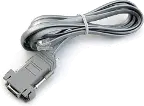
RS232 cable, meter to PC, P/N CBL01
Laureate 1/8 DIN Laureate instruments must be equipped with a serial communications board and be connected to the computer via a serial communications cable. The connection can be via RS232, RS485, USB or Ethernet. Following setup, the serial communications board may be removed from the instrument if desired. The wiring of the RS232 cable is illustrated above with end views of the two connectors.
Laureate LT Series transmitters come standard with a 3-wire serial interface, which can be jumpered for RS232 or RS485.
Laureate LTE Series transmitters come standard with an Ethernet interface.
Meter Setup Screens
Click on any of the reduced screens below for a full-size screen view, then click on the Back button of your browser to return to this page. The screens examples below are for a fully-loaded Series 2 Digital Panel Meter (DPM), which is connected to the PC via RS232. If the meter is a Series 1 meter (pre-2007), this is sensed by the software, and somewhat different screens are brought up. Please see Series 1 setup screens.











Meter Setup Utilities




From the Main Menu, click on Readings if your PC is connected to the meter. A pull-down menu then offers three choices: List, Plot and Graph.
- List presents the latest readings in a 20-row by 10-column table. Press Pause at any time to freeze the display. This is one method to capture peak readings.
- Plot generates a plot of readings vs. time in seconds. It effectively turns the DPM-PC combination into a printing digital oscilloscope.

- Graph generates a histogram where the horizontal axis is the reading and the vertical axis is the number of occurrences of readings. The display continually resizes itself as the number of readings increases.



Laureate™ 1/8 DIN Case For Laureate Digital Panel Meters, Counters, Timers & Remote Displays
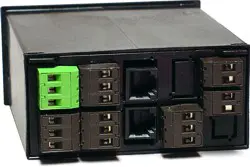
Key Features
- Meets 1/8 DIN Standard.
- Installs from front of panel.
- Short depth behind the panel: only 4" (102 mm) plus connectors.
- Understated 0.157" (4 mm) thick bezel.
- Meets NEMA 4X (IP-65) for high-pressure wawshdon when panel mounted.
- Screw clamps connectors meet VDE / IEC / UL / CSA safety standards.
- Rugged GE Lexan® housing material.
- Safety certified per EN 61010-1.
Dimensions
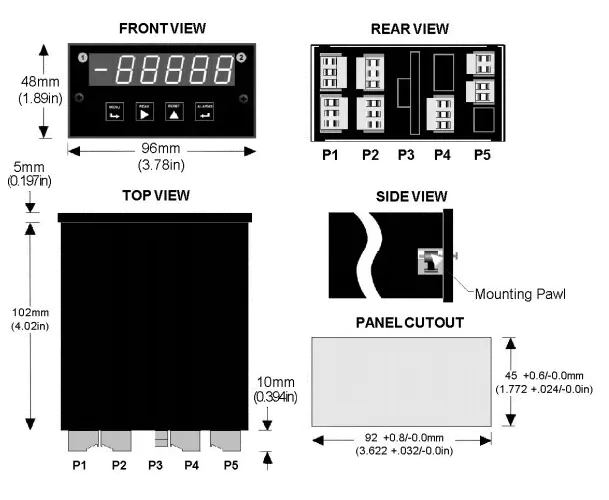
Maximum panel thickness: 4.5 mm (0.18")
Weight of base meter: 210 g (7.4 oz) typical (DPM, counter, timer, 6-digit remote display)
Weight of option boards: 30 g (1.0 oz) typical per board (analog output, relay output, communications)
Tightening Torque - Connectors: Screw terminal connectors: 5 lb-in (0.56 Nm)
Tightening Torque - Pawls: Digital Panel Meter Case Pawls: 5 lb-in (0.56 Nm)
Dimensioned CAD assembly drawings in EPRT, STEP, x_t. dwg, pdf file formats: Laureate-meter-case.zip (zipping prevents browser from opening CAD files as text files).
Panel Mounting
 Slide the meter into a 45 x 92 mm 1/8 DIN panel cutout. Ensure that the provided gasket is in place between the front of the panel and the back of the meter bezel.
The meter is secured by two pawls, each held by a screw, as illustrated. Turning each screw counterclockwise extends the pawl outward from the case and behind the panel. Turning each screw clockwise further tightens it against the panel to secure the meter.
Slide the meter into a 45 x 92 mm 1/8 DIN panel cutout. Ensure that the provided gasket is in place between the front of the panel and the back of the meter bezel.
The meter is secured by two pawls, each held by a screw, as illustrated. Turning each screw counterclockwise extends the pawl outward from the case and behind the panel. Turning each screw clockwise further tightens it against the panel to secure the meter.
Turning each screw counterclockwise loosens the pawl and retracts it into its well. This position allows installed meter to be removed from their panel, or new meters to be installed in a panel. Do not remove the screws from their pawls. Doing so would cause the screw and pawl to fall off and likely get lost. Do not overtighten so as not to damage the plastic parts.
Load Cell Meter Frequently Asked Technical Questions
1) Relay setpoint offset,
2) Count-by function,
3) Fixed right-hand dummy zero,
4) Auto-zero function,
5) Manual tare function.
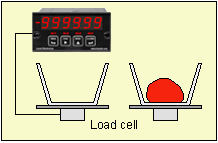
To read the net weight of an object, the empty container is first weighed, and an external button is pushed to zero out the display. The meter will then read net weight when an object is added to the empty container. The tare value is stored in memory for subsequent readings.
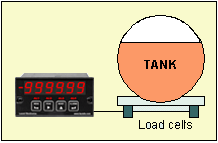
An easy way to determine volume of an irregularly shaped tank with no need for linearizing is to weigh the tank using load cells. The meter will automatically tare out the weight of the empty tank and then scale the load cell signals to units of volume, such as liters or gallons.
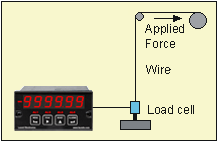
Peak readings are automatically captured at rates up to 60 per second, while the display updates at a legible 3.5 per second. The peak reading can be recalled at the push of a button or be always displayed. It can also be transmitted to a computer via RS232, RS485, USB or Ethernet.
DLS-XLOG2
XLog2 Data logging Software
CON01
CON01 Connector
IPC
Splashproof Cover
CBL01
RS232 Cable for Meters
CBL02
USB-to-RS232 Adapter Cable
CBL04
RS232 Cable for LT Transmitters
CBL05
USB Data Cable for Meters
CBL06
USB-to-RS485 Adapter Cable
CBL07
USB Programming & Data Cable
CBL08
RS485 Splitter Cable
BKBD
RS485 RJ11 Terminal Block Adapter
Modular Design for Maximum Flexibility at Minimum Cost
All boards are isolated from meter and power grounds. Optional Plug-in-Play boards for communications and control include Ethernet, WiFi, serial communication boards, dual or quad relay boards, and an analog output board. Laureates may be powered from 85-264 Vac or optionally from 12-32 Vac or 10-48 Vdc. The display is available with bright red or green 0.56" (14.2mm) high LED digits. The 1/8 DIN case meets NEMA 4X (IP65) specifications from the front when panel mounted. Any setup functions and front panel keys can be locked out for simplified usage and security. A built-in 5, 10, 12, or 24 Vdc excitation supply can power transducers, eliminating the need for an external power supply. All power and signal connections are via UL / VDE / CSA rated screw clamp plugs.
The Laureate™ Series features modular design with up to 7 isolated plug-in boards, applicable to all Laureate 1/8 DIN Panel Meters.

Modular Hardware
The design of the Laureate™ Series is modular for maximum flexibility at minimum cost. All boards are isolated from meter and power grounds. The base configuration for panel meters or counter consists of a main module (with computer and plug-in display boards), a power supply board, and a signal conditioner board. Optional plug-in-play boards include an isolated setpoint controller board, an isolated analog output board, and an isolated digital interface board. Modular design and a choice of plug-in options allow the Laureate to be customized for a broad range of applications from simple monitoring to control and computer interface. There can be up to five plug-in boards in a 1/8 DIN Laureate.

Connecting Laureate Panel Meters to a Local Area Network (LAN)
Up to 30 Laureate Panel Meters and/or LT Transmitters can be configured for RS485 and daisy-chained to an LT Transmitter using Laurel’s High Speed Ethernet-to-RS485 converter board for seamless LAN integration. Alternatively, Laurel LTE series Ethernet transmitters can connect directly to a LAN via an Ethernet cable. Setup for both configurations is streamlined using Laurel’s free Instrument Setup Software, which simplifies node discovery and transmitter configuration.
Flexible Communication Options for Panel Meters
Laureate Panel Meters can be equipped with Laurel communication boards to support various interfaces and protocols. These include serial interfaces with ASCII or Modbus RTU protocols, and Ethernet interfaces with web access, ASCII, or Modbus TCP/IP protocols, ensuring versatile connectivity for your commercial applications.

What are 1/8 DIN Panel Meters for Load Cell, Strain Gauge, and Microvolt Measurements?
In the realm of precision measurement and data acquisition, 1/8 DIN Panel Meters are critical instruments designed to display and monitor a variety of electrical signals with high accuracy. Specifically engineered to interface with load cells, strain gauges, and microvolt-range signals, these Panel Meters are indispensable in industrial, laboratory, and scientific applications where precise measurement of force, strain, or minute electrical signals is required. Their compact design, high precision, and versatility make them essential for ensuring operational efficiency, safety, and data integrity across diverse sectors.
Understanding 1/8 DIN Panel Meters
The term "1/8 DIN" refers to the standardized size of these Panel Meters, defined by the Deutsches Institut für Normung (DIN), the German Institute for Standardization. With dimensions of approximately 96 x 48 mm (3.78 x 1.89 inches), 1/8 DIN Panel Meters are compact, allowing seamless integration into control panels or instrumentation setups where space is limited. This standardized size ensures compatibility with existing panel cutouts, simplifying installation and replacement in various environments.
Panel Meters are designed to convert analog signals from sensors, such as load cells, strain gauges, or microvolt sources, into a clear, digital format for real-time monitoring. Their high-resolution displays and robust features make them ideal for applications requiring accurate and reliable measurement of low-level signals, ensuring precise data for critical decision-making.
How Do 1/8 DIN Panel Meters Work?
1/8 DIN Panel Meters for load cell, strain gauge, and microvolt measurements operate through a systematic process to deliver accurate and reliable data:
- Signal Acquisition
The Panel Meters receive analog input signals from connected sensors, such as load cells, strain gauges, or other devices outputting microvolt-level signals. These sensors detect physical phenomena like force, weight, pressure, or deformation and convert them into electrical signals. - Signal Conditioning
The incoming analog signal is conditioned to ensure it falls within the operational range of the Panel Meters. This may involve amplification to boost low-level signals, filtering to remove noise, or other adjustments to enhance measurement accuracy. - Analog-to-Digital Conversion
An internal Analog-to-Digital Converter (ADC) transforms the conditioned analog signal into a digital value. This high-precision conversion is critical for accurately representing minute changes in the input signal, especially for microvolt measurements. - Display and Output
The digital signal is processed and displayed on a high-resolution LED or LCD screen, typically offering 4-6 digits for detailed readouts. Panel Meters also provide output options, such as analog signals, relay outputs, or communication interfaces (e.g., RS-485, Modbus RTU), for integration with control systems or data logging platforms. - Calibration and Configuration
Panel Meters can be calibrated to ensure measurement accuracy and configured to meet specific application needs, including setting measurement ranges, units (e.g., kilograms, pounds, or newtons), and scaling factors.
Key Features
1/8 DIN Panel Meters for load cell, strain gauge, and microvolt measurements are equipped with advanced features to enhance their performance and adaptability:
- High Precision: Capable of measuring signals in the microvolt range with accuracies of ±0.01% or better, ensuring reliable data for sensitive applications.
- Compact Design: The 1/8 DIN size allows easy integration into space-constrained control panels, optimizing space without sacrificing functionality.
- Versatile Input Compatibility: Supports a variety of sensors, including load cells, strain gauges, and other low-voltage sources, accommodating diverse measurement needs.
- Customizable Display: Features adjustable brightness, color options, and display formats for enhanced readability in various lighting conditions.
- Robust Construction: Designed with rugged enclosures and high IP ratings (e.g., IP65) for protection against dust, moisture, and harsh industrial environments.
- Communication Capabilities: Includes serial or network interfaces (e.g., RS-232, RS-485, Modbus RTU, Ethernet) for seamless integration with control systems.
- Programmable Alarms: Allows configuration of thresholds to trigger alerts or automated actions when measurements exceed specified limits.
Benefits of Using 1/8 DIN Panel Meters
Implementing 1/8 DIN Panel Meters offers several advantages:
- Enhanced Accuracy: High-resolution measurements ensure precise data for critical applications, reducing errors and improving outcomes.
- Space Efficiency: The compact 1/8 DIN size optimizes panel space, reducing installation costs and complexity.
- Versatility: Compatible with a wide range of sensors and applications, from industrial weighing to scientific research.
- Real-Time Monitoring: Provides immediate feedback, enabling quick adjustments to maintain system performance and safety.
- Cost-Effective: Combines multiple functions into a single device, reducing the need for additional equipment and lowering overall costs.
Technical Specifications
Typical specifications for 1/8 DIN Panel Meters for load cell, strain gauge, and microvolt measurements include:
- Input Range: Microvolt to millivolt signals, with support for load cell and strain gauge outputs.
- Accuracy: ±0.01% of full scale or better.
- Display: 4-6 digit LED or LCD with customizable decimal points.
- Power Supply: 12-24V DC or 85-265V AC.
- Communication: RS-232, RS-485, Modbus RTU, or Ethernet.
- Environmental Rating: IP65 or higher for front panel protection.
- Operating Temperature: -10°C to 50°C, suitable for industrial environments.
Applications of 1/8 DIN Panel Meters
- Load Cell Measurements
Panel Meters are used in industrial and laboratory settings to measure force, weight, or pressure via load cells. They provide accurate, real-time weight or force data for applications like quality control, material handling, and inventory management. - Strain Gauge Monitoring
Strain gauges measure deformation or strain in materials or structures. Panel Meters display these measurements, supporting applications such as structural health monitoring, material testing, and mechanical analysis in industries like construction and manufacturing. - Microvolt Measurements
For applications requiring ultra-sensitive measurements, such as scientific research or precision instrumentation, Panel Meters accurately capture and display microvolt-level signals, ensuring reliable data for experiments or sensor calibration. - General Industrial Use
Beyond specific sensors, Panel Meters are widely used in process control, system diagnostics, and automation, providing critical feedback for optimizing operations in diverse industrial environments.
Where Are 1/8 DIN Panel Meters for Load Cells, Strain Gauges, and Microvolts Used?
1/8 DIN Panel Meters are essential in various industries for monitoring and displaying measurements from load cells, strain gauges, and microvolt sensors. Their compact size, high precision, and robust features make them ideal for applications requiring accurate and reliable data. Below are the primary areas where these Panel Meters are deployed:
- Industrial Weighing Systems
Panel Meters are integral to industrial weighing systems, where load cells convert force or weight into electrical signals. These Panel Meters amplify and display the signals in real-time, supporting applications in manufacturing, agriculture, and logistics for tasks like batch weighing, inventory management, and compliance with regulatory standards. - Material Testing and Research Laboratories
In research and material testing facilities, strain gauges measure material deformation under stress. Panel Meters capture and display these microvolt-level signals, enabling researchers to analyze properties like tensile strength, elasticity, or fatigue. This is critical for developing new materials or ensuring compliance with performance standards in industries like aerospace or automotive. - Automation and Process Control
In automated systems, Panel Meters monitor forces, weights, or tensions from load cells and strain gauges, providing real-time feedback for process optimization. They are used in industries like automotive manufacturing, where precise control of assembly processes ensures product quality and safety. - Aerospace and Defense
Panel Meters are employed in aerospace and defense to test the structural integrity of components under extreme conditions. They measure signals from strain gauges and load cells, ensuring the reliability of aircraft, spacecraft, or defense systems through accurate data on forces and stresses. - Energy and Power Generation
In the energy sector, Panel Meters monitor mechanical forces in turbines, generators, or other equipment using strain gauges or load cells. They provide precise microvolt measurements to maintain equipment efficiency, prevent failures, and ensure a reliable energy supply in power plants or renewable energy systems. - Medical Devices and Health Monitoring
In medical applications, Panel Meters display signals from load cells or strain gauges in devices like patient monitoring systems, prosthetics, or surgical instruments. Their high precision ensures accurate feedback, critical for patient safety and effective medical device operation. - Construction and Structural Monitoring
Panel Meters are used in construction to monitor strain in bridges, buildings, or other structures using strain gauges. They provide real-time data on structural health, helping engineers detect potential issues like material fatigue or stress overload.
Conclusion
1/8 DIN Panel Meters for load cell, strain gauge, and microvolt measurements are versatile and essential tools across a wide range of industries, including industrial weighing, material testing, automation, aerospace, energy, medical, and construction. Their compact design, high precision, and robust integration capabilities ensure accurate and reliable measurement of low-level signals, supporting operational efficiency, safety, and innovation. As industries continue to demand precise and reliable data, these Panel Meters remain critical for optimizing processes and ensuring high standards of performance and reliability. Less Information.









